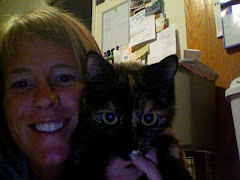Waters, John K. (2009, March 1). The kids are all right. T.H.E. Journal, Retrieved 4/1/09, from http://www.thejournal.com/articles/24104_1
In his article "The Kids Are All Right," John Waters investigates the impact that digital technologies may have on student's learning, focusing on a particular study of the John D. and Katherine T. MacAurthur Foundation. The study supports the idea that digital technology enhances learning. He explores ways that teachers use their student's familiarity and knowledge of digital technologies to further a student's education.
Waters mentions that many teachers are familiar with little or none of the current technology their students are using outside of the classroom. The author explains that, since students view the technology as an integral part of their everyday lives, when teachers refuse to see value in it, the students perceive teachers and their curriculum as irrelevant. The article calls on teachers to find creative ways to reach out to their students, using the technology that their students use to communicate with each other.
The author then takes a closer look at the study, introducing the term "media ecologies," which are defined as "collections of interconnected technologies and activities involving new media." The study used three "genres of participation," to explain students' various levels of participation in new media activities. These levels are:
Hanging Out--This level is often friendship-driven, according to researchers, who say that kids today are using online social networks the same way that their parent's generation hung out at the mall. In this level of contact, kids "move seamlessly between online and offline worlds, compensating in some ways for their increasingly restricted lives." Kids involved on this level use digital technology to learn social skills that were once learned face-to-face.
Messing Around-- The study describes this as a "hybrid level," which combines elements of Hanging Out and Geeking Out. In this level, kids are developing interests, and searching for information about them in a self-directed way. Waters describes this as "a level of playing around that leads to interest-driven activities."
Geeking Out-- This is described as "a level of intense interest, even a high level of commitment, with media or technology." At this level, the research is about a subject of interest, rather than the focus being on the technology. According to Waters, this is the level of engagement that teachers really want to see, and he encourages teachers to search for ways to use technology to peak their students interest.
Waters concludes by re-stating that educators need to see the value in the time kids spend online, whatever their level of involvement is. The article stresses that teachers need to be open and receptive to technologies their students are using, and how they are using them. As educators, it is important to find ways to use technology as a tool to communicate with students, rather than seeing it as a barrier between teachers and students.
In his article "The Kids Are All Right," John Waters investigates the impact that digital technologies may have on student's learning, focusing on a particular study of the John D. and Katherine T. MacAurthur Foundation. The study supports the idea that digital technology enhances learning. He explores ways that teachers use their student's familiarity and knowledge of digital technologies to further a student's education.
Waters mentions that many teachers are familiar with little or none of the current technology their students are using outside of the classroom. The author explains that, since students view the technology as an integral part of their everyday lives, when teachers refuse to see value in it, the students perceive teachers and their curriculum as irrelevant. The article calls on teachers to find creative ways to reach out to their students, using the technology that their students use to communicate with each other.
The author then takes a closer look at the study, introducing the term "media ecologies," which are defined as "collections of interconnected technologies and activities involving new media." The study used three "genres of participation," to explain students' various levels of participation in new media activities. These levels are:
Hanging Out--This level is often friendship-driven, according to researchers, who say that kids today are using online social networks the same way that their parent's generation hung out at the mall. In this level of contact, kids "move seamlessly between online and offline worlds, compensating in some ways for their increasingly restricted lives." Kids involved on this level use digital technology to learn social skills that were once learned face-to-face.
Messing Around-- The study describes this as a "hybrid level," which combines elements of Hanging Out and Geeking Out. In this level, kids are developing interests, and searching for information about them in a self-directed way. Waters describes this as "a level of playing around that leads to interest-driven activities."
Geeking Out-- This is described as "a level of intense interest, even a high level of commitment, with media or technology." At this level, the research is about a subject of interest, rather than the focus being on the technology. According to Waters, this is the level of engagement that teachers really want to see, and he encourages teachers to search for ways to use technology to peak their students interest.
Waters concludes by re-stating that educators need to see the value in the time kids spend online, whatever their level of involvement is. The article stresses that teachers need to be open and receptive to technologies their students are using, and how they are using them. As educators, it is important to find ways to use technology as a tool to communicate with students, rather than seeing it as a barrier between teachers and students.
Questions:
1. What level of participation will most of my future students likely be at?
In my opinion, most students are at the "hanging out" level. As teacher, I hope to move students up to at least the "messing around" level, so that they can start developing various areas of interest, while also developing technology skills.
2. What are some ways that I can show my students that I appreciate and understand the role that technology plays in their lives?
Integrating technology in my classroom will show students that I am "down" with technology. By becoming familiar with the technology available in my classroom, and practicing operating the equipment, I will model technological proficiency for my students and earn their respect with this knowledge. By using tools such as social bookmarking, a class blog, and email, I will be able to communicate with students and parents efficiently, offering them opportunities to connect with me as a teacher, as well as with other students in the learning community.



No comments:
Post a Comment